Scientific name: Cercis canadensis L. var. texensis ‘Oklahoma’ (S.Watson) M.Hopkins
Common name: ‘Oklahoma’ Texas redbud
Family: Fabaceae
By Susan Bruneni
Early colonial gardeners were delighted when redbuds signaled spring was near with a splash of pink blossoms. George Washington and Thomas Jefferson applauded the beauty they contributed to their landscapes. Settlers named the tree “redbud.”
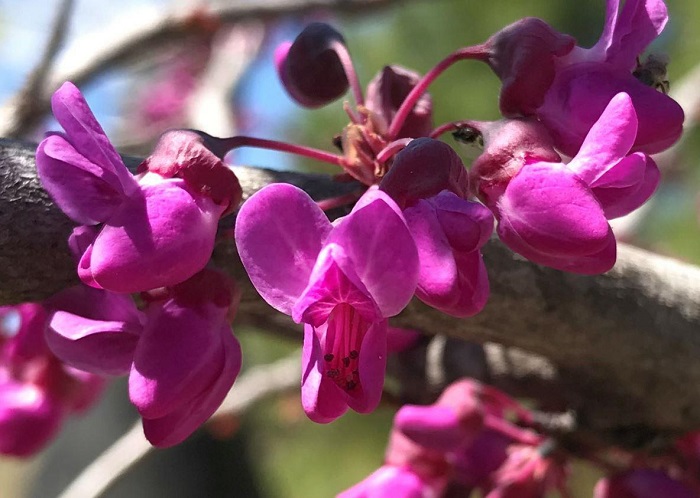
‘Oklahoma’ Texas redbud flowers at Santa Fe Botanical Garden. Photo: Cristina Salvador
There are three geographic varieties of Cercis canadensis, and the most eastern (C. canadensis var. canadensis) has a native range along the Atlantic coast to central Texas. Variety texensis ranges from Oklahoma south through central Texas to northeastern Mexico. The tree was so prominent in Oklahoma that it was named the State Tree in 1937. And in 1964, the ‘Oklahoma’ redbud was found growing wild in the Arbuckle Mountains of south-central Oklahoma. It featured even more attractive reddish-purple blooms and darker, shinier foliage.
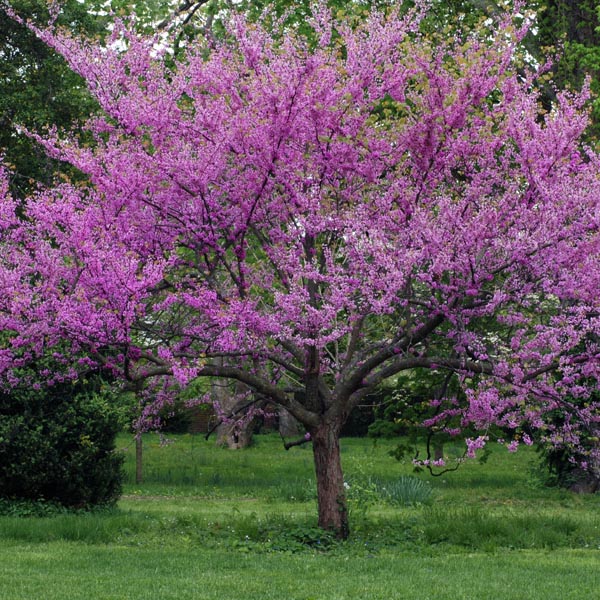
Photo: Oklahoma Redbud ‘Oklahoma’ (Cercis canadensis texensis), mygardenlife.com.
Redbud has always bloomed earlier than other flowering trees but ‘Oklahoma’ redbud blooms one-two weeks earlier. ‘Oklahoma’ mature height is 12’-18’, much smaller that the Eastern redbud (20’-30’). Mature width is 16’-22’ (Eastern redbud is 20’-30’). This compact size is more suitable for smaller spaces and patios. It prefers full sun to partial shade and moist, well-drained soil. It is hardy in zones 6-9.
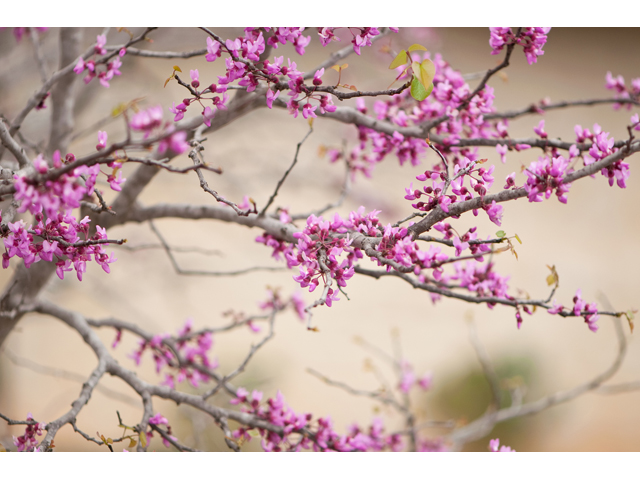
Photo: Bruce Leander, Lady Bird Johnson Wildflower Center.
The genus name Cercis comes from the Greek word “kerkis” which means weaver’s shuttle, referring to the seed pod’s resemblance to the size and shape of a weaver’s shuttle which is used to move thread back and forth on a loom. The name redbud comes from its inner bark that bears a reddish color.
The Cercis genus is spread throughout North America, the Middle East, and North Africa. The Eastern redbud ranges from Canada to Florida and from the Atlantic coast west to sporadic patches on the Great Plains. The ‘Oklahoma’ redbud is native only to Oklahoma and Texas, but is widely available through nurseries and grows throughout the hardiness zones described above.
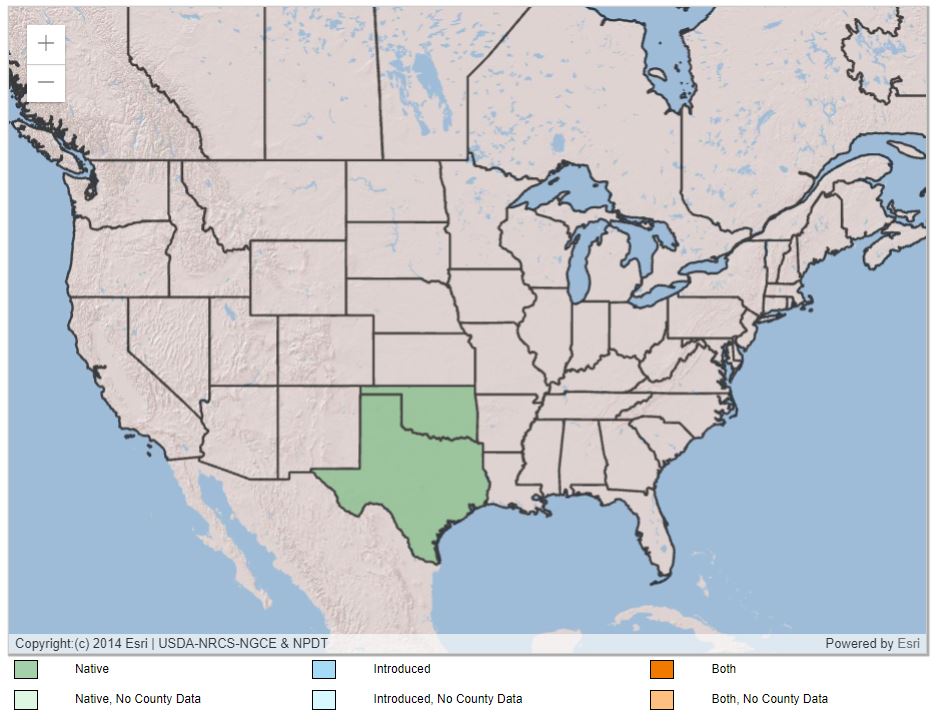
Cercis canadensis var. texensis native range. Credit: USDA, NRCS. 2022. The PLANTS Database.
The wood is heavy, hard, and close-grained, but because of the small size and irregular shape of the tree it is of no commercial value as a source of lumber. This tree is most valued as an ornamental and is extensively planted for its showy spring blooms and valentine-shaped leaves.

Photo: Cristina Salvador
Unlike the vast majority of leguminous species in the Fabaceae family, redbuds are not known to form root nodules and therefore do not form symbiotic relationships with nitrogen-fixing bacteria called rhizobia. This might have something to do with their preference for rich forest soils where they originated, where plenty of nitrogen was already available.
One of the most interesting aspects of redbuds is their flowers. They are not borne on the tips of branches as is the case with many flowering trees. Instead, they grow directly from the trunks and branches. This is called “cauliflory,” which literally translates to “stem-flower”. In older specimens, the trunks and branches are riddled with bumps from years of flower and seed production.
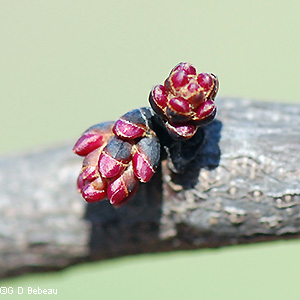
Flower buds just breaking open. Photo: G. D. Bebeau ©2015 Friends of the Wild Flower Garden, Inc.
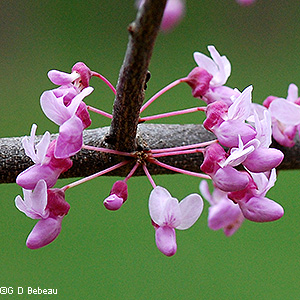
Flowers of the the cluster fully developed. Photo: G. D. Bebeau ©2015 Friends of the Wild Flower Garden, Inc.
Cauliflory is often found in dense tropical forests where flowers on trunks and stems are more available to small insects and other pollinators common in forest understories. It also facilitates seed dispersal.
Buds, flowers, pods, seeds and leaves are edible. Flowers are high in vitamin C. Buds can be picked, pickled, and used in place of capers. When in full bloom, blossoms can be eaten by the handful, and can make a unique addition to a salad or other dishes. In early spring, the young leaves are good to eat as well. After flowering, two-to-three-inch pods form and dangle in clusters. When young and tender they can be steamed, boiled or pickled.
Redbud pods are an inch across, and dangle in clusters from the branches beginning in late spring and early summer. Dried pods were prepared by Native tribes who buried intact pods in hot coals and roasted them. When cooled, they would dig them out, shell the cooked seeds, and eat them whole. (The dry seeds contain between 22-27-percent protein and 7-8-percent fat.)
Settlers used an infusion of the bark as a febrifuge and cough suppressant to treat colds, fevers, and. influenza. It also is useful for calming the digestive tract.
Natives used the pure black charcoal for black war paint. Many tribes also traditionally scattered redbud wreaths and twigs around their dwellings, to help “drive out the spirit of winter” and bring on planting time.
Keep the tree healthy and vigorous by regular watering and fertilization and by pruning out dead branches as needed. A nursery can help determine types of pests and treatment.
Flowers provide nectar for bees and the seeds can be consumed by birds. Members of the genus Cercis support the specialized bee Habropoda laboriosa.
References
Candeias, Matt. “Meet the Redbuds”. In Defense of Plants. 12 April 2017. Web. 18 Jan 2022. Retrieved from: https://www.indefenseofplants.com/blog/2017/4/12/meet-the-redbuds.
“Cercis canadensis var. texensis ‘Oklahoma'”. Garden Explorer. Santa Fe Botanical Garden. Web. 18 Jan 2022. Retrieved from: https://santafebotanicalgarden.gardenexplorer.org/taxon-1332.aspx.
“Cercis canadensis var. texensis ‘Oklahoma'”. Plant Finder. Missouri Botanical Garden. Web. 18 Jan 2022. Retrieved from: https://www.missouribotanicalgarden.org/PlantFinder/PlantFinderDetails.aspx?taxonid=295790.
“Cercis canadensis var. texensis (Texas redbud)”. USDA, NRCS. 2022. The PLANTS Database (http://plants.usda.gov, 01/30/2022). National Plant Data Team, Greensboro, NC USA. Retrieved from: https://plants.usda.gov/home/plantProfile?symbol=CECAT.
Native Plant Information Network, NPIN (2013). Published on the Internet http://www.wildflower.org/plants/ [accessed January 30, 2022]. Lady Bird Johnson Wildflower Center at The University of Texas, Austin, TX.
NatureServe. 2022. NatureServe Explorer [web application]. NatureServe, Arlington, Virginia. Available https://explorer.natureserve.org/. (Accessed: January 30, 2022).
“Oklahoma Redbud Cercis canadensis var. texensis ‘Oklahoma’. North Carolina Extension Gardener Plant Toolbox. N.C. Cooperative Extension. Web. 18 Jan 2022. Retrieved from: https://plants.ces.ncsu.edu/plants/cercis-canadensis-var-texensis-oklahoma/common-name/oklahoma-redbud/.


